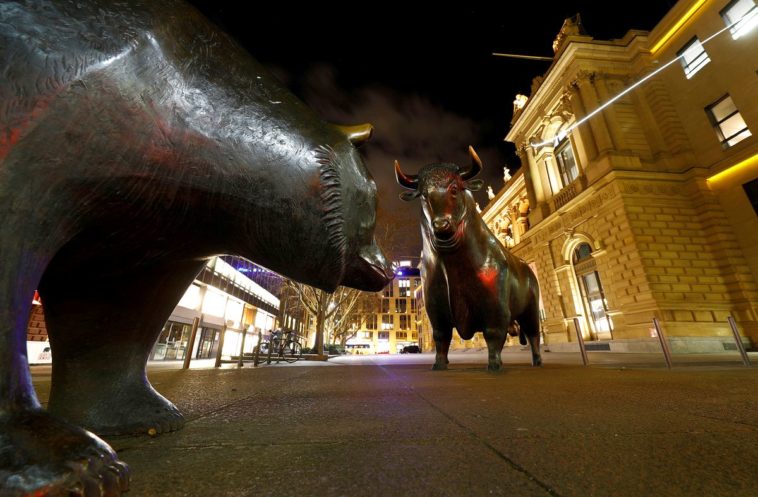‘Where is the bubble?’: Money manager, pension expert square off over highflying stock market
/cloudfront-us-east-1.images.arcpublishing.com/tgam/FJVKW352ERIFVKAP5QMYGOUEG4.JPG)
Bull and bear symbols in front of the German stock exchange in Frankfurt, Germany, Feb. 12, 2019.
KAI PFAFFENBACH/Reuters
Let us pause for a moment to ponder this remarkably baffling moment in investing history.
Never before has a global pandemic collided with near-zero interest rates and gushers of fiscal stimulus to produce a stock market that – depending on your druthers – is either the only game still worth playing or a bubble on the verge of popping.
Bears point to some of the loftiest stock valuations in history – not to mention the hunger for bitcoin, electric-vehicle startups and speculative investments of all stripes – and ask how long the madness can possibly endure. Bulls counter that investors have no realistic alternative. When bonds pay next to nothing and are practically guaranteed to erode your purchasing power, stocks look very attractive indeed.
The debate between these opposing viewpoints can grow fierce. I know because I’ve had the opportunity over the past few months to take my lumps from two well-respected professionals who are at the opposite ends of the debate.
The first is John De Goey, a portfolio manager at Wellington-Altus Private Wealth in Toronto. He is also the author of several well-regarded books on how to reform the financial planning industry.
I have known Mr. De Goey for a couple of decades. I had always regarded him as primarily an index investor – that is, someone who was not inclined to make large active bets on the course of the market. So it surprised me when he informed me in early March of last year, just as the novel coronavirus was starting to flare into a global emergency, that he had heavily reduced his clients’ stock exposure. Many were completely out of conventional equities, except for shares of gold producers.
“I don’t believe people can reliably pick stocks or time markets, but I do believe there are times when market valuations are high (and return expectations correspondingly low),” he wrote. He admonished me for advising readers to remain calm at such a perilous moment.
As it turned out, Mr. De Goey was right, at least in the short term. Markets plunged. Panic reigned.
Then came a massive outpouring of government support. Central banks slashed interest rates. Support programs bloomed. Stocks came roaring back over the months that followed and topped their previous peaks.
Had Mr. De Goey’s mind changed? Not at all. He saw the COVID-19 response as encouraging even sillier behaviour and even more erratic valuations. “I believe it will end very badly – and very soon,” he wrote me recently.
His position struck me with particular force because I had simultaneously been exchanging thoughts with Keith Ambachtsheer, one of Canada’s best-known pension experts. He is president of the consulting firm KPA Advisory Services and director emeritus of the International Centre for Pension Management at the University of Toronto.
He is also someone who scoffs at talk of a stock-market bubble. “You and the people you quote all talk about ‘the stock market’ as though it is some homogenous thing from a valuation perspective,” he told me.
In fact, stocks span a wide range of valuations – some cheap, some expensive – and investors willing to pick and choose can simply decide to avoid the frothier areas, he said. They can, for instance, sidestep Tesla Inc., a speculative company with unpredictable leadership and a share price at nosebleed levels, and load up instead on Unilever PLC, a solid, well-managed company with shares that trade at a reasonable price with a significant dividend.
For discriminating buyers, “WHERE IS THE BUBBLE?” Mr. Ambachtsheer wrote me with a hint of exasperation. (The capitals were his.)
That is a fine question. And I thought one way to explore it would be to set up a three-way exchange between Mr. Ambachtsheer, Mr. De Goey and myself. Not only did this plan possess the undeniable advantage of removing me as the pinata in a contest between two opposing cudgels, but I hoped it would also spark some interesting exchanges between two experts with such divergent opinions.
And so it did. The bull-versus-bear dialogue wrapped up earlier this week. Here are some highlights.
The case for bearishness
Stocks as a whole are trading at freakishly high multiples of their long-run earnings potential.
Getty Images/iStockphoto
If there is one question that preoccupies investors’ minds these days it is the issue of whether markets are in a bubble – that is, an unsustainable and irrational period of euphoria.
To Mr. De Goey’s mind, the answer is clear: “Not only do I think stocks are in a bubble right now, I think bonds and real estate are in bubble territory, too.”
When it comes to stocks, he pointed to two indicators that buttress his point.
The first is a comparison of U.S. stocks’ current prices to their earnings over the long run – or, at least, over the past decade. This indicator, made famous by Yale professor Robert Shiller, is known as the cyclically adjusted price-to-earnings ratio, or CAPE. It now stands at its second-loftiest point in history, trailing only the late-1990s dot-com lunacy.
CAPE’s message seems clear: Stocks as a whole are trading at freakishly high multiples of their long-run earnings potential.
Mr. De Goey’s second benchmark makes a similar point. It is known as the Buffett indicator because famed investor Warren Buffett has cited it as one of his favourite gauges. It compares the market capitalization of the stock market to gross domestic product, which is a broad measure of the value created by the economy as a whole.
In recent months, the Buffett indicator has reached its highest level on record, suggesting that stocks have never before been so richly valued in comparison to the underlying economy. Again, the message seems clear.
The “public policy response to COVID has created a monster,” Mr. De Goey argued. Thanks to near-zero interest rates, generous support programs and bored, cash-rich consumers, there is “a bubble in all major asset classes,” with stocks being a prime example.
The bullish comeback
A man wearing a mask passes the Charging Bull statue in New York’s financial district, Sept. 8, 2020.
Mark Lennihan/The Associated Press
But so what? The stock market as a whole may well be frothy, but Mr. Ambachtsheer fired back that people should remember “that investing in ‘the market’ is not the only investment option.”
His simple rule, he wrote, is to look for individual stocks that can provide a long-run real return exceeding 4 per cent, with an expected return that is at least two percentage points higher than that provided by real-return bonds. (Real-return bonds pay a set yield over and above whatever the prevailing inflation rate happens to be.)
With real-return bonds now offering real yields barely above zero, it is not difficult to find investments that meet these dual criteria, Mr. Ambachtsheer wrote.
One of his favourite examples is Unilever, the long-established British consumer-goods company that owns brands such as Hellmann’s and Lipton. At the moment, it offers a dividend yield around 3.6 per cent. If you assume the company can grow that dividend at a modest 1.5 per cent a year, “it easily surpasses my 4 per cent real-return cutoff rate,” Mr. Ambachtsheer wrote. (His math reflects the well-known Gordon growth model, which shows a stock’s expected return being equal to its current dividend yield plus the projected growth rate of the dividend.)
He noted that he has not always been so positive about stocks. Back in 2000, for instance, the expected real return on stocks was around 4 per cent – just about identical to the payoff then available on real-return bonds. Given the lack of any equity risk premium, he argued investors had little reason to favour stocks.
These days, though, selected stocks do offer a clear advantage over the miserable yields available on fixed-income alternatives. To Mr. Ambachtsheer, that suggests long-term investors should take advantage of the premium on offer.
“On your ‘bubble’ question, I think we agree the answer appears to be ‘yes’ at this point in the bond, cryptocurrency and retail real estate markets,” he noted. “However, I would not attach the ‘b’ word to the entire stock market.” By his criteria, many stocks still qualify as attractive investments.
So what to do?
Investors who don’t want to go quite so far in search of safety can still reduce their risk in more conventional ways.
Daniel Haller/Getty Images/iStockphoto
As you might expect, Mr. Ambachtsheer likes stocks that meet his criteria and thinks pension plans should favour them to the outright exclusion of bonds. “With negative real return expectations, bonds currently have no role in the investment policies” of most pension plans, he wrote in his advisory letter.
In our conversation, he acknowledged that individual investors have shorter-term horizons than pension funds. Given the need for individuals to generate income and draw down their savings in retirement, he recognized that some investors may have the need to protect themselves against short-term volatility with some cash, bonds or other holdings.
But stocks should still do the heavy lifting, he suggested. Consider the case of his own firm’s pension fund, he told me. The diversified collection of stocks generates a 5-per-cent dividend yield and weathered the pandemic without incident.
As you might expect, Mr. De Goey sees things differently. He is not convinced the next stretch will turn out so well. Stock markets have historically not remained at their current elevated valuations for long, he noted. He expects a correction to occur soon and argues that individual investors should protect themselves by dialling back their level of risk.
How conservative should you be? That depends on your individual circumstances. Mr. De Goey has positioned many of his clients well away from conventional stocks and bonds. Instead, they hold a mix of equity-linked and principal-protected guaranteed investment certificates, mortgage funds, gold stocks, cash and custom-built inverse notes that will rise if markets drop.
Investors who don’t want to go quite so far in search of safety can still reduce their risk in more conventional ways. If your portfolio is ordinarily 60 per cent stocks and 40 per cent bonds, consider a “tactical 10 per cent move” that would move you temporarily to a 50-50 blend, Mr. De Goey suggested.
Raising cash is also a good idea, Mr. De Goey wrote. So is increasing exposure to “non-correlated assets” such as gold. Finally, “if you insist on maintaining exposure to overpriced assets in general, try to find those segments that represent good value.” That might mean buying a value-oriented exchange-traded fund (ETF) rather than one that covers the broad market.
Wait … is that agreement I hear?
While Mr. Ambachtsheer and Mr. De Goey may have differed on many issues, they did agree on several points, including the need to find better ways to manage Canadians’ savings to generate adequate retirement incomes.
“The average Canadian mutual fund materially underperforms the market year after year,” primarily because of the high fees they charge, Mr. Ambachtsheer noted. He called for public policy that would shift retail retirement savings away from the current high-cost retail model and toward cost-effective pension plans.
For Mr. De Goey, the problem is one of attitude. “The financial advice business has this maddening habit of being perpetually bullish,” he wrote.
This “optimism bias” does not serve clients well, he noted: “If advisers are to be responsible stewards of their clients’ accumulated lifetime assets, surely there must be some instances when prudence and caution are more appropriate than bullishness.”
Be smart with your money. Get the latest investing insights delivered right to your inbox three times a week, with the Globe Investor newsletter. Sign up today.
Published at Sat, 10 Apr 2021 11:00:00 +0000






Comments
Loading…